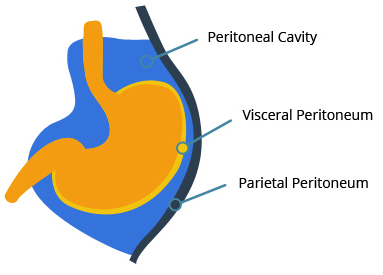Peritoneal Mesothelioma
 Peritoneal mesothelioma is a cancer of the peritoneum, which is the lining of the abdomen. It is the second most common type of mesothelioma and with pleural mesothelioma makes up the vast majority of all diagnoses. Incidence rates for the peritoneal cancer vary, but it’s thought to occur in ten to twenty percent of malignant mesothelioma diagnoses. There is some evidence to suggest that the number of diagnoses in the United States are on the rise.
Peritoneal mesothelioma is a cancer of the peritoneum, which is the lining of the abdomen. It is the second most common type of mesothelioma and with pleural mesothelioma makes up the vast majority of all diagnoses. Incidence rates for the peritoneal cancer vary, but it’s thought to occur in ten to twenty percent of malignant mesothelioma diagnoses. There is some evidence to suggest that the number of diagnoses in the United States are on the rise.
Function of the Peritoneum
The peritoneum is a serous membrane that lines the body’s abdominal cavity and secretes a fluid to provide for increased movement and reduced friction among the organs in the midsection. Like the pleura, there are two parts to the peritoneum: the visceral peritoneum and the parietal peritoneum. The visceral peritoneum covers the internal organs and makes up most of the outer layer of the intestinal tract. The parietal peritoneum lines the abdominal cavity.
Symptoms and Diagnosis of Peritoneal Mesothelioma
One of the most common symptoms of peritoneal mesothelioma is abdominal pain, due to tumor invasion of the peritoneum which often comprises both its elasticity and its ability to filter fluids throughout the abdominal cavity. However, like the symptoms of pleural mesothelioma, it is often difficult to diagnose in its early stages because its symptoms often mimic the symptoms of other abdominal illnesses.
Some of the symptoms shared by peritoneal mesothelioma and other illnesses include:
- Upper abdominal pain
- Abdominal swelling due to fluid retention or tumor growth
- Cough and shortness of breath
- Fever
- Weight loss
- Fatigue
- Anemia
- Digestive disturbances
Because of these similarities and the relative rarity of asbestos cancer in the general population, the disease often grows untreated because the doctor was treating a different ailment. More invasive diagnostic techniques are not often used until the symptoms become more pronounced. Thus, when one is actually diagnosed with peritoneal mesothelioma, one’s cancer is often quite advanced. This could mean that multiple tumors have already invaded the peritoneum, that the cancer has spread to the lymph nodes and/or that the cancer has metastasized to other parts of the body, such as the lungs or the heart.
To learn more about the symptoms, please read: mesothelioma symptoms.
To learn more about the diagnosis, please read: mesothelioma diagnosis.
Treatment and Prognosis of Peritoneal Mesothelioma
All general prognostic guidelines and treatment regimens for mesothelioma are based on the pleural form of the disease. Because of this, most of the information we have regarding treatment and prognosis of peritoneal mesothelioma is anecdotal. However, this does not mean that the data should be ignored. Scientists have been gathering more and more information about peritoneal disease and clinical studies are ongoing that specifically study treatment regimens for this variety of mesothelioma.
There is no cure for peritoneal mesothelioma. However, peritoneal often presents with a better prognosis and a longer life expectancy than does its pleural counterpart. Histologically, peritoneal mesothelioma is most often of the epithelial subtype, which is the type most amenable to treatment. The sarcomatous subtype rarely presents in peritoneal disease, so many treatment regimens seem to have a better response rate with peritoneal mesothelioma. While the pleural disease has an average life expectancy of a year to 16 months from diagnoses, it is not uncommon for victims of peritoneal disease to live two to five years after diagnosis.
A notable example of greater-than-average life expectancy, as well as one of the most famous people diagnosed with mesothelioma, was Harvard University professor Stephen J. Gould, an internationally renowned paleontologist and evolutionary biologist. Dr. Gould was diagnosed with peritoneal mesothelioma in 1982. After an initial period of depression, he became hopeful and was determined to not let the statistics regarding life expectancy beat him. When he finally died in 2002, it was from another totally unrelated form of cancer. Dr. Gould has written about his experience and his determination to not let simple statistics dictate his reaction to his diagnosis in the essay, “The Median Isn’t the Message.” We recommend Dr. Gould’s essay for everyone who has been diagnosed with this disease.
Dr. Gould’s experience certainly may not be standard, but his hopeful approach to his diagnosis cannot be discounted. Peritoneal mesothelioma is a very serious disease and it must be taken seriously as such. However, treatments are improving, as are the prognoses of those diagnosed.


